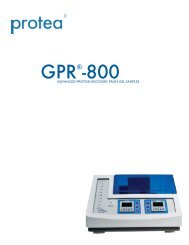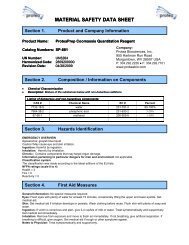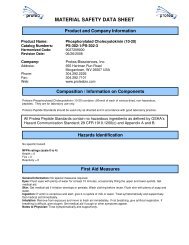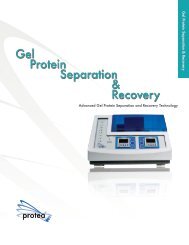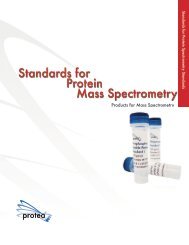Biochemistry NPD Review - Protea Biosciences
Biochemistry NPD Review - Protea Biosciences
Biochemistry NPD Review - Protea Biosciences
Create successful ePaper yourself
Turn your PDF publications into a flip-book with our unique Google optimized e-Paper software.
MATERIAL SAFETY DATA SHEET<br />
Section 1.<br />
Product and Company Information<br />
Product Name:<br />
Silver Stain Kit (Enhancer)<br />
Catalog Numbers: SS-100-kit / SS-101-kit<br />
UN Number: 2209<br />
Harmonized Code: 2912110000<br />
Revision Date: 08/14/2009<br />
Company:<br />
<strong>Protea</strong> <strong>Biosciences</strong>, Inc.<br />
955 Hartman Run Road<br />
Morgantown, WV 26507 USA<br />
P: 304.292.2226 ● F: 304.292.7101<br />
www.proteabio.com<br />
Section 2.<br />
Composition / Information on Components<br />
<br />
<br />
Chemical Characterization<br />
Description: Mixture of the substances below with non-hazardous additions.<br />
Listing of dangerous and non-hazardous components:<br />
CAS # Chemical Name EC # Percent<br />
30425-89-4 Formaldehyde 200-001-8 30-40%<br />
Section 3.<br />
Hazards Identification<br />
EMERGENCY OVERVIEW<br />
Appearance: colorless liquid<br />
Caution! May cause eye, skin, and respiratory tract burns.<br />
Ingestion: Harmful by ingestion<br />
Inhalation: Harmful by inhalation<br />
Chronic: Danger of serious damage to health by prolonged exposure through inhalation, skin contact, and ingestion.<br />
Information pertaining to particular dangers for man and environment: not applicable<br />
Classification system<br />
The classification was made according to the latest editions of the EU-lists.<br />
NFPA ratings (scale 0 to 4)<br />
Health = 3<br />
Fire = 0<br />
Reactivity = 0<br />
Section 4.<br />
First Aid Measures<br />
General Information: No special measures required.<br />
Eyes: Flush eyes with plenty of water for at least 15 minutes, occasionally lifting the upper and lower eyelids. Get<br />
medical aid.<br />
Skin: Get medical aid if irritation develops or persists. Wash clothing before reuse. Flush skin with plenty of soap and<br />
water.<br />
Ingestion: If victim is conscious and alert, give 2-4 cupfuls of milk or water. Treat symptomatically and supportively.<br />
Get medical aid immediately.<br />
Inhalation: Remove from exposure and move to fresh air immediately. If not breathing, give artificial respiration. If<br />
breathing is difficult, give oxygen. Get medical aid if cough or other symptoms appear.<br />
Notes to Physician: Treat symptomatically and supportively.
Section 5.<br />
Fire Fighting Measures<br />
General Information: As in any fire, wear a self-contained breathing apparatus in pressure-demand, MSHA/NIOSH<br />
(approved or equivalent), and full protective gear. Dusts at sufficient concentrations can form explosive mixtures with<br />
air. Combustion generates toxic fumes.<br />
Extinguishing Media: Use water spray, dry chemical, carbon dioxide, or chemical foam.<br />
Flash Point: Not available.<br />
Section 6.<br />
Accidental Release Measures<br />
General Information: Use proper personal protective equipment as indicated in Section 8.<br />
Spills/Leaks: A vacuum or sweep up material and place into a suitable disposal container. Clean up spills<br />
immediately, observing precautions in the Protective Equipment section. Do not allow to enter sewers, surface, or<br />
ground water. Absorb with liquid-binding material (sand, diatomite, acid binders, universal binders, sawdust).<br />
Section 7.<br />
Handling and Storage<br />
Handling: Wash thoroughly after handling. Remove contaminated clothing and wash before reuse. Ground and<br />
bond containers when transferring material. Avoid contact with eyes, skin, and clothing. Empty containers retain<br />
product residue, (liquid and/or vapor), and can be dangerous. Keep container tightly closed. Do not ingest or<br />
inhale. Do not pressurize, cut, weld, braze, solder, drill, grind, or expose empty containers to heat, sparks or<br />
open flames. Use only with adequate ventilation. Keep away from heat, sparks and flame. Avoid use in confined<br />
spaces. Avoid breathing vapor or mist.<br />
Storage: Keep away from heat, sparks, and flame. Keep away from sources of ignition. Store reagent at room<br />
temperature away from incompatible substances. Keep containers tightly closed.<br />
Section 8.<br />
Exposure Control / Personal Protection<br />
Engineering Controls: Facilities storing or utilizing this material should be equipped with an eyewash facility and a<br />
safety shower. Use adequate ventilation to keep airborne concentrations low.<br />
Exposure Limits:<br />
Formaldehyde, 50-00-0<br />
PEL<br />
0.75 ppm TWA<br />
Personal Protective Equipment<br />
Eyes: Wear appropriate protective eyeglasses or chemical safety goggles as described by OSHA's eye and face<br />
protection regulations in 29 CFR 1910.133 or European Standard EN166.<br />
Skin: Wear appropriate gloves to prevent skin exposure.<br />
Clothing: Wear appropriate protective clothing to prevent skin exposure.<br />
Respirators: Follow the OSHA respirator regulations found in 29 CFR 1910.134 or European Standard EN 149. Use<br />
a NIOSH/MSHA or European Standard EN 149 approved respirator if exposure limits are exceeded or if irritation or<br />
other symptoms are experienced.<br />
Section 9.<br />
Physical and Chemical Properties<br />
Physical State: liquid<br />
Appearance: colorless<br />
Odor: odorless<br />
pH: Not available.<br />
Vapor Pressure: Not available.<br />
Vapor Density: Not available.<br />
Evaporation Rate: Not available.<br />
Boiling Point: Not available.<br />
Melting Point: Not available.<br />
Decomposition Temperature: Not available.<br />
Solubility: Fully miscible in water.<br />
Specific Gravity/Density: Not available.<br />
Molecular Formula: Not available<br />
Molecular Weight: Not available
Section 10.<br />
Stability and Reactivity<br />
Chemical Stability: Stable under normal temperatures and pressures.<br />
Thermal decomposition / conditions to be avoided: Incompatible materials, dust generation, excess heat.<br />
Dangerous reactions: No dangerous reactions known.<br />
Hazardous Decomposition Products: Will not occur.<br />
Section 11.<br />
Toxicological Information<br />
Silver Stain Enhancer<br />
RTECS#:<br />
CAS# 50-00-0<br />
LD50/LC50:<br />
LD50 Oral 100 mg/kg Rat<br />
LD50 Dermal 270 mg/kg Rabbit<br />
Carcinogenicity:<br />
CAS# 50-00-0: Suspected Carcinogen<br />
Epidemiology: No data available.<br />
Teratogenicity: No data available.<br />
Reproductive Effects: No data available.<br />
Mutagenicity: No data available.<br />
Neurotoxicity: No data available.<br />
Section 12.<br />
Ecological Information<br />
Ecotoxicity: No data available. No information available.<br />
Environmental: Water hazard class 1: slightly hazardous for water. Do not allow undiluted product or large<br />
quantities of it to reach ground water, water course, or sewage system.<br />
Physical: No information available.<br />
Section 13.<br />
Disposal Considerations<br />
Chemical waste generators must determine whether a discarded chemical is classified as a hazardous waste. US<br />
EPA guidelines for the classification determination are listed in 40 CFR Parts 261.3. Additionally, waste generators<br />
must consult state and local hazardous waste regulations to ensure complete and accurate classification.<br />
RCRA P-Series: None listed.<br />
RCRA U-Series: None listed.<br />
Section 14.<br />
Transport Information<br />
DOT Regulations:<br />
Hazard Class: 8 (Corrosive)<br />
Land transport ADR/RID (cross border):<br />
ADR/RID Class: -<br />
Maritime transport IMDG:<br />
IMDG Class: 8<br />
Marine Pollutant: No<br />
Air transport ICAO-TI and IATA-DGR:<br />
ICAO/IATA Class: 8<br />
Transport / Additional information: Not dangerous according to the above specifications.
Section 15.<br />
Regulatory Information<br />
US Federal<br />
TSCA<br />
CAS: 50-00-0 is listed on the TSCA Inventory<br />
SARA Reportable Quantities (RQ)<br />
The components are on this list<br />
CERCLA/SARA Section 313<br />
The components are on this list<br />
OSHA – Highly Hazardous<br />
None of the components are on this list<br />
US State<br />
State Right to Know<br />
CAS# 50-00-0 is present on state lists from CA, PA, MN, MA, FL, or NJ.<br />
European/International Regulations<br />
Canada Ingredient Disclosure List<br />
CAS# 50-00-0 is listed on Canada’s Ingredient Disclosure List.<br />
Section 16.<br />
Other Information<br />
MSDS Creation Date: 08/14/2009<br />
Revision #1 Date: 08/14/2009<br />
The information above is believed to be accurate and represents the best information currently available to us.<br />
However, we make no warranty of merchantability or any other warranty, express or implied, with respect to such<br />
information, and we assume no liability resulting from its use. Users should make their own investigations to<br />
determine the suitability of the information for their particular purposes. In no event shall <strong>Protea</strong> <strong>Biosciences</strong> be liable<br />
for any claims, losses, or damages of any third party or for lost profits or any special, indirect, incidental,<br />
consequential or exemplary damages, howsoever arising, even if <strong>Protea</strong> <strong>Biosciences</strong> has been advised of the<br />
possibility of such damages.



